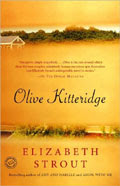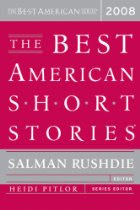 Elizabeth Stout has won the 2008 Pulitzer Prize for her latest novel “Olive Kitteridge”. This book has been referred to as a novel in stories. There are thirteen chapters (she’s not superstitious!) each with its own title. The story brings to life the small coastal town of Crosby, Maine with all the quirkiness and charm of a small New England town. The tie that binds this novel together is the main character, a middle aged seventh grade math teacher, whose name is Olive Kitteridge. Olive is a force to be reckoned with. She has become a large woman in middle age, who has little patience for the changes that that have taken over her home town or the people that inhabit it. Her husband, her son and most people find Olive to be a difficult person. Her son states it clearly, “You can make people feel terrible”. Olive appears in all the stories, sometimes as the main character, a few times as a fleeting presence.
Elizabeth Stout has won the 2008 Pulitzer Prize for her latest novel “Olive Kitteridge”. This book has been referred to as a novel in stories. There are thirteen chapters (she’s not superstitious!) each with its own title. The story brings to life the small coastal town of Crosby, Maine with all the quirkiness and charm of a small New England town. The tie that binds this novel together is the main character, a middle aged seventh grade math teacher, whose name is Olive Kitteridge. Olive is a force to be reckoned with. She has become a large woman in middle age, who has little patience for the changes that that have taken over her home town or the people that inhabit it. Her husband, her son and most people find Olive to be a difficult person. Her son states it clearly, “You can make people feel terrible”. Olive appears in all the stories, sometimes as the main character, a few times as a fleeting presence.In the first chapter we meet Henry Kitteridge, Olive’s husband who is then the town’s Pharmacist. Henry is the opposite of Olive. He is quiet, reflective and remembered by everyone as kind. But as the stories progress we see another side of Olive. She is blunt and impatient but she is also incredibly empathetic. When she meets a young women who is blatantly anorexic, she cries. When she encounters a former student who wants to kill himself, she shares her past with him to let him know he isn’t alone in his sadness and depression. In one of the most startling chapters, “Tulips”, Olive goes to visit a woman who has shut herself away in her home because of a tragedy. Olive sympathetically reaches out to the woman but what she finds is someone who has lost her mind.
The joy of reading this story comes as the author weaves these complex characters together. All of the characters embody someone you know. Each character, whether you like them or not, is a strong force in this novel. But the most wonderful character is Olive herself as you watch her develop into a woman who understands where she came from and how she must change to be the person she wants to be. This “novel in stories” is a wonderful, compelling book that brings character development to a new level.









